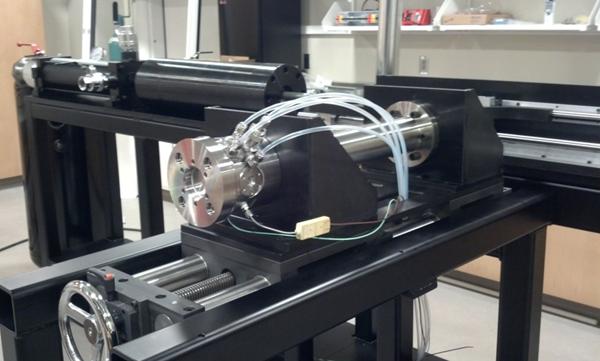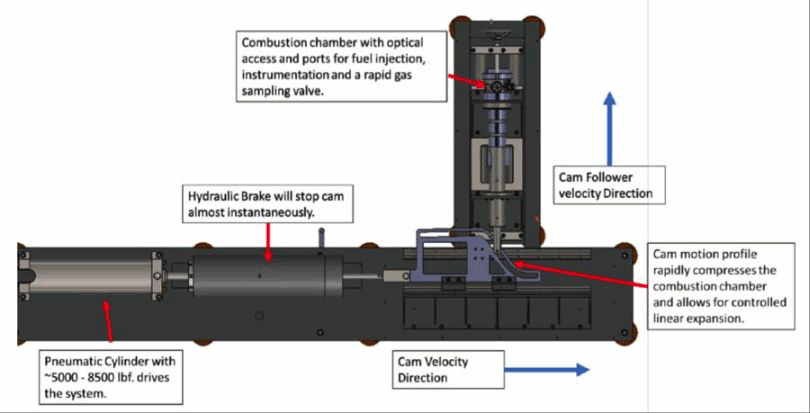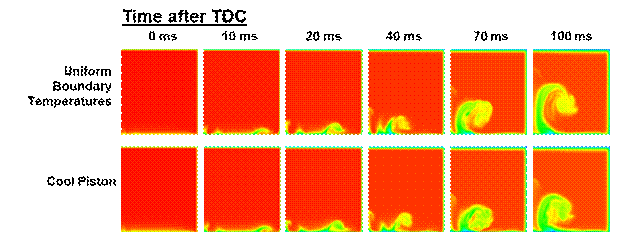Reports: DNI653521-DNI6: High-Fidelity Iso-Octane Ignition Kinetics: New Rigor for an Unresolved Problem
Casey Allen, PhD, Marquette University
The main objectives of this project can be summarized as (1) experimentally-determining iso-octane ignition delay times and their susceptibility to heat loss effects and (2) using these data to recommend a heat loss modeling approach for rapid compression machine (RCM) experiments.
Experimental measurements were proposed in a variable-speed compression-expansion machine (VSCEM) that rapidly compresses a reactive mixture to elevated temperatures and pressures to induce autoignition. The VSCEM is designed so that during the ignition delay period, the induced mixture will be slightly expanded to cool the mixture. Operating conditions of the VSCEM allow this rate of expansion to be altered, and provide the basis for experimentally emulating the influence of heat loss characteristics on ignition delay measurements. A schematic of the VSCEM appears in Figure 1, where it is noted that the shape of the cam can be altered to change the expansion (i.e., emulated heat loss) characteristics for an experiment. More mild changes to the expansion characteristics can be achieved by changing the operating conditions and working fluid in the hydraulic brake. Photographs of the VSCEM appear in Figures 2 and 3.
Figure 1. Top-down VSCEM schematic.
The VSCEM was
commissioned shortly after the start of the project, but one of the components
failed during testing, damaging the machine and requiring a redesign of some
components. During a test, tensile failure of the piston rod connecting the
pneumatic cylinder rod to the linear cam occurred, causing the cam to become
airborne. The cam and rod assembly was damaged in the process as it collided
with the wall. The weak point in the design has been identified and the
redesign completed. The new parts are presently being fabricated, and the PI estimates
that the iso-octane ignition delay measurements will resume in one month.
Figure 2. Photograph of the VSCEM showing the test chamber.
Figure 3. Photograph of the VSCEM showing the linear cam. Given the delays in
experimentation, we have been conducting computational fluid dynamics (CFD) simulations
to explore the influence of non-uniform boundary conditions on ignition delay
time measurements from RCMs. These simulations support this research project
because both efforts are directed at gaining additional insight into the lack
of agreement in experimental data from different RCMs. In heated RCM
experiments, open loop temperature control is often used and can lead to
non-uniformities in the boundary temperatures, especially on the piston crown.
The non-uniform boundary temperatures lead to a non-homogeneous initial
temperature field in the gas. The role of this thermal heterogeneity is
disregarded when modeling RCM experiments, but no analysis has been done to
determine whether that assumption is acceptable. In these simulations, an
initial condition is obtained by performing a steady-state simulation of the
temperature field using a set of prescribed boundary conditions. The case of
fully-uniform boundary temperatures is compared to the case where the piston
crown is 25 K cooler than the surrounding walls (at 398 K). The initial
temperature fields for these cases appear in Figure 4. Qualitative analysis of
the temperature fields that develop during the simulation suggest that a
creviced piston is effective at suppressing the influence of the initially-cool
boundary layer on the compressed temperature field (Figure 5). Simulations with
a flat piston (not shown) indicate that the non-uniform boundary temperatures
play a more influential role on the compressed temperature field. The
temperature field analysis has been conducted using inert mixtures. Ongoing
simulations are assessing how the non-uniformities impact the actual ignition
delay times. Simulations of the compressed temperature fields were reported in
January 2014 at the 52nd AIAA Aerospace Sciences Meeting, which was
sponsored by the American Institute of Aeronautics and Astronautics. The
additional simulation work for ignition delay times will be used as the basis
for a peer-reviewed journal publication.
Figure 4. Initial temperature fields for uniform boundary and “cool
piston” cases. Figure 5. Compressed temperature fields for uniform boundary
temperatures and a cool piston case where the piston crown is 25 K cooler than
the wall temperatures. Temperature fields are compared at various
post-compression times. We have also used
the CFD model to assess how the expansion stroke of the VSCEM will influence
temperature field homogeneity when a creviced piston is used. Fluid dynamic
effects are minimized when using a creviced piston as the boundary layer mass
flows into the crevice. The reversal of this flow during expansion will
influence the temperature field in the VSCEM. Simulation results shown in
Figure 6 indicate that even at rapid expansion rates, the core region of the
gas remains relatively unaffected by the crevice flow. These simulations will
be an important justification for treating the core gas in the VSCEM
experiments as being thermally-homogeneous.
Figure 6. VSCEM temperature fields during expansion.
Preliminary
simulation results from this project have been reported in a conference venue,
and have provided insight into the influence of non-uniform boundary conditions
on compressed temperature field development in heated RCM experiments. These
results are significant because of the lack of agreement in RCM data in the
literature. These simulations suggest that boundary conditions play a minor
role in the discrepancy provided that a creviced piston is used for the
experiments. The PI expects that the forthcoming iso-octane ignition
delay data will be highly-valuable for the RCM testing community when
determining how to compare their data with other measurements in the
literature. By obtaining the grant award early in his career cycle, the funding
has been very critical to jump-starting the PI’s career. It has provided recognition
within the College of Engineering and has supported the PI’s successful
application for additional internal funding. New sources of external funding
have been extensively sought, but with no success to date. One graduate student
(John Neuman) is supported by the grant, and working on the project has been
critical for his development as a researcher. The project has provided Mr.
Neuman the opportunity to learn about ignition chemistry, CFD modeling,
numerical analysis, and reactor design.

















